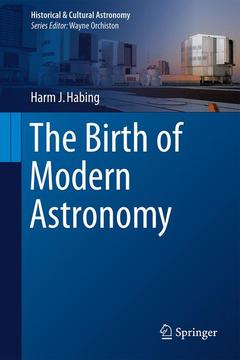Description
The Birth of Modern Astronomy, 1st ed. 2018
Historical & Cultural Astronomy Series
Author: Habing Harm J.
Language: English
Subjects for The Birth of Modern Astronomy:
565 p. · 15.5x23.5 cm · Hardback
Description
/li>Biography
/li>Comment
/li>
This richly illustrated book discusses the ways in which astronomy expanded after 1945 from a modest discipline to a robust and modern science. It begins with an introduction to the state of astronomy in 1945 before recounting how in the following years, initial observations were made in hitherto unexplored ranges of wavelengths, such as X-radiation, infrared radiation and radio waves. These led to the serendipitous discovery of more than a dozen new phenomena, including quasars and neutron stars, that each triggered a new area of research.
The book goes on to discuss how after 1985, the further, systematic exploration of the earlier discoveries led to long-term planning and the construction of new, large telescopes on Earth and in Space. Key scientific highlights described in the text are the detection of exoplanets (1995), the unexpected discovery of the accelerated expansion of the Universe (1999), a generally accepted model for the large-scale properties of the Universe (2003) and the ?CDM theory (2005) that explains how the galaxies and stars of the present Universe were formed from minute irregularities in the (almost) homogenous gas that filled the early Universe.
All these major scientific achievements came at a price, namely the need to introduce two new phenomena that are as yet unexplained by physics: inflation and dark energy. Probably the deepest unsolved question has to be: Why did all of this start with a Big Bang?
Professor Harm J. Habing obtained his PhD in astronomy from the University of Groningen in 1968 under Dr. Sr.R. Pottasch. He did his postdoc at the University of California under Prof. G. Field before becoming a senior researcher at Leiden University in 1970. In 1980, he became a full professor at Leiden University, where he remained until his retirement in 2002. During his time at Leiden University, he acted as chairman several times, and he served as the scientific director from 1995-2002. In addition, he supervised 28 graduate students.
Professor Habing has published over 350 papers in scientific journals and has written multiple books, including “Asymptotic Giant Branch Stars” (Springer). Further, he has received the Medal for Exceptional Scientific Achievement from NASA and the Gilles Holst medal in gold from the Royal Dutch Academy of Science. He is also Chevalier de l’ ordre de la Légion d’honneur.
Comprehensively describes how a global “new astronomy” was born with the emergence of radio, infrared and X-ray astronomy and the surprising evolution of optical astronomy, along with the new possibilities offered by satellites in space, electronic computers and the Internet
Organized by the development of new instruments and the pivotal discoveries they facilitated
Written by a leading expert who has been both a participant and witness to these developments over the entire 60-year period, from 1945 to 2015




